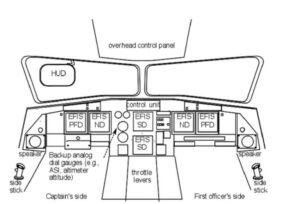
Human Factor research focuses on studying the capacities and shortcomings of human systems. Aircraft designers intend to use this information to reduce the mismatch between what is expected of human beings and what they can do. If this imbalance is corrected, mistakes that have led to accidents will be minimized, and human efficiency will be maximized. The word ‘ergonomics’ refers to understanding human relationships and interactions. In order to ensure that not only does the person feels safe in the use of the system, ergonomics also increases the overall efficiency of the system, which ensures the customer’s safety in purchasing the product.
Aviation safety depends heavily on the maintenance of the aircraft. If servicing is not carried out properly, it will increase the percentage of aircraft crashes and injuries. Examples of repair failures include improperly assembled components, missing parts, and not using the correct procedures during inspections. Aviation maintenance technicians (AMT) have a harder time detecting these safety risks. Such errors are frequently present but not apparent and can stay latent, impacting an aircraft’s stable operation for longer periods. AMTs have a challenge when collecting human factors in aviation. They work in the evening or early morning hours, in small areas, on high-rise platforms, and in a range of unfavorable temperature or humidity conditions. Employers will need to pay attention to details even when dealing with physical strenuousness, and because of the design of the maintenance activities, AMTs typically spend more time planning for duty than actually completing it. The study of ergonomics can be categorized into four forms of thought: structures, architecture, humanistic, and science. System thinking will enable the product designer to consider the system’s many facets, including its goals, structure, boundaries, dynamics, and outcomes. Such systems can be applied to research to design a method that will help the end-user. Design thinking will include the use of principles and processes that can affect human efficiency. Solutions are typically expected to resolve these issues in concepts and procedures.
On the other hand, humanistic thinking involves awareness, wholeness, intention, meaning values, choice, and responsibility. This thought style deals with ethical and moral questions, or some other human-related problems that could impact the framework put in place in the industry. Scientific thinking involves understanding the problem specification, hypothesizing, predicting, observing, measuring, and testing. This thinking and design practice are designed to maximize human activities, wellness, and general machine output. For instance, the use of fire control systems will need to be evaluated in locations where fire detection instruments, such as bleed air ducts, engines, and Auxiliary Power Units (APU) are required, etc; this includes the four styles of the thought needed to obtain the relevant results in aviation safety and assist pilots in detecting in-flight fire.
Automation has influenced many aspects of the modern age. In the aviation sector, the impacts of automated processes are clear. For example, automation has reduced the workload of a pilot by providing information such as fuel calculations and where the top of the climb is built. Automation refines the flight path and takes care of many tasks performed by the pilot, such as measurement of take-off and approach speeds. Although automation has made flying a lot safer and reduces the pilot’s workload while maintaining his situational awareness, automation failure can lead to severe implications if the pilot is too reliant on it. Hence, pilots should not become overly dependent on automation; instead, they should use all of the cockpit resources during emergencies. In the NextGen setting, pilots will be relieved of the strict discipline of being spread in nose-to-tail time blocks, over less-than-optimum paths, and sometimes at inefficient altitudes. Extended to its ultimate use, NextGen will embrace the aircraft’s full function: from the start-up at the originating airport to the shutdown at the destination. When pilots have flown a clear non-deviating route, this allows pilots to have maximum performance figures that seem to be right out of the operating manual of the airframe manufacturer.
Operators would need to add new avionics, the most important being focused on ADS-B technologies. Current Mode S transponders will gradually have a much more sophisticated function to play as ADS-B is introduced. Datalink radios, which can be used to transfer as much information as possible over distinct controller-pilot frequencies, are also required for NextGen. As soon as the NextGen-based traffic regime transition begins, analysts trust that airlines will start upgrading the existing fleet reasonably quickly. The technical obstacles involved are massive but not insurmountable, which means that the future might be nearer than we know. From a human factors point of view, the NextGen flight deck’s radical developments also present new possibilities for human error and major training challenges.